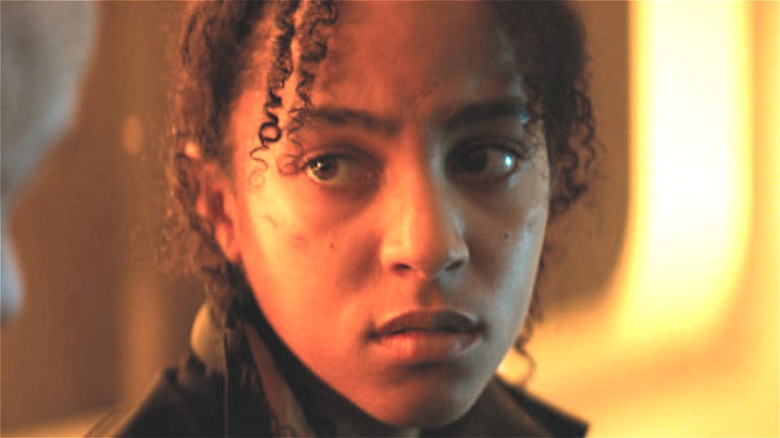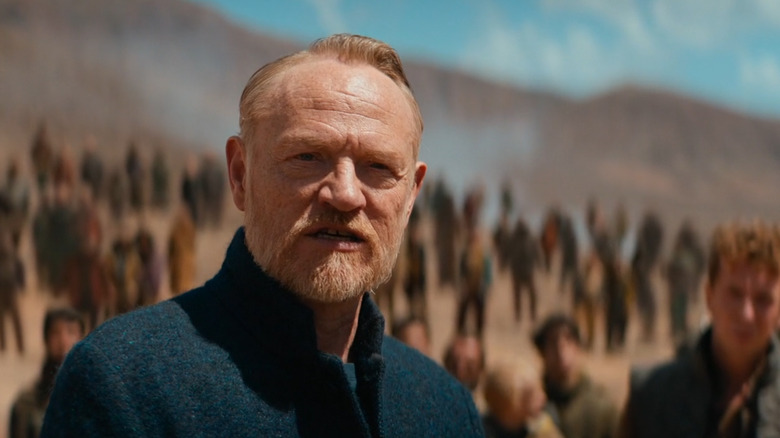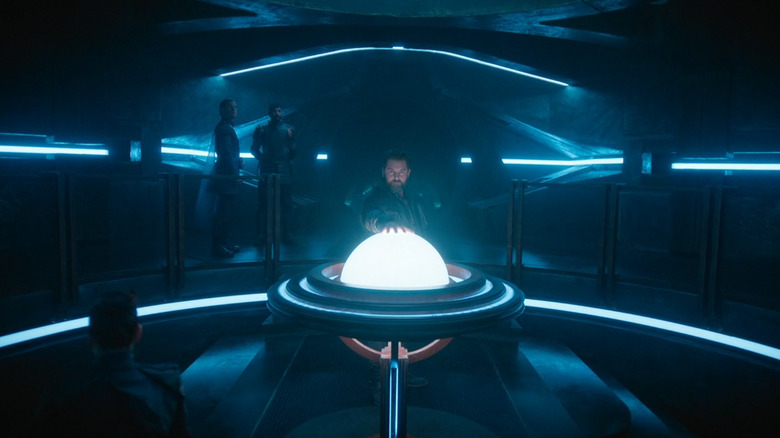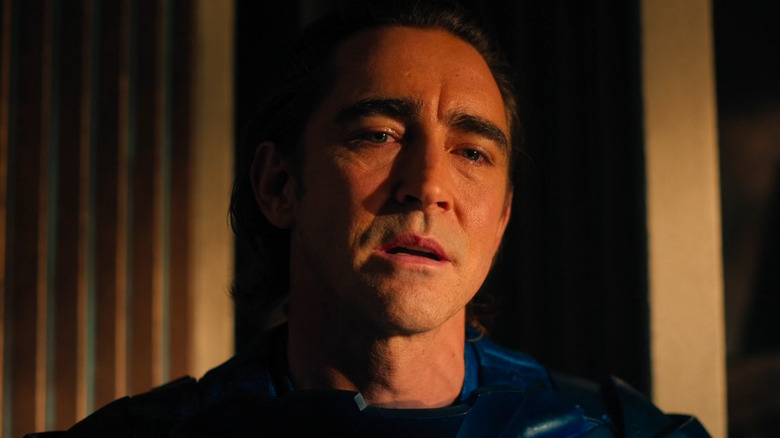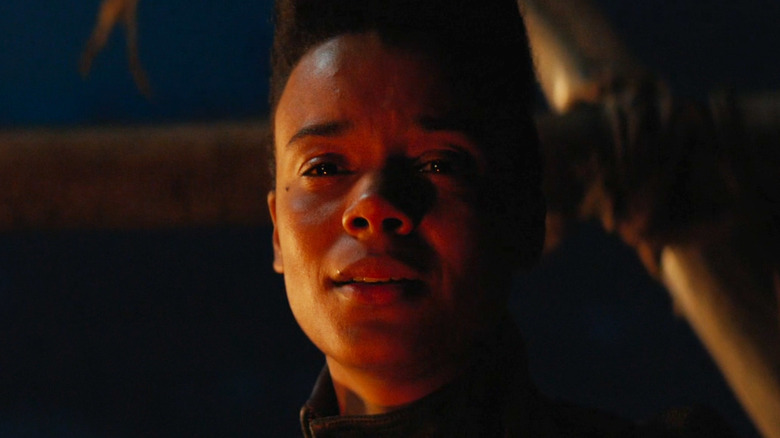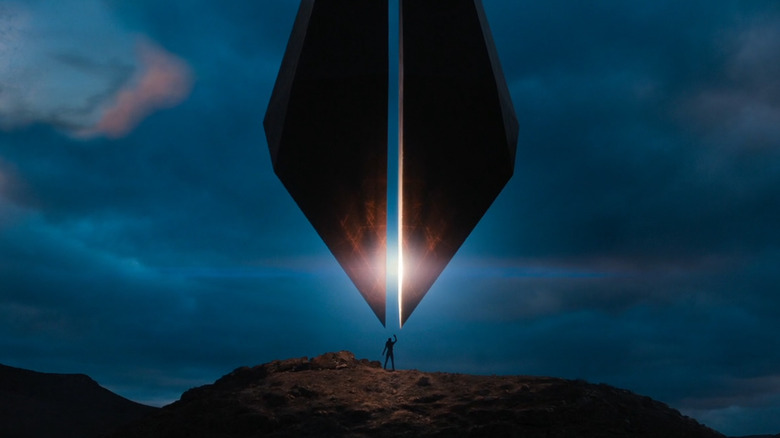The Ending Of Foundation Season 1 Explained
On November 19, Apple TV+ released the final episode of "Foundation" Season 1. As its source material, "Foundation" pulls from a series of books of the same name by author Isaac Asimov. At the core of both the show and its progenitor are a collapsing galactic empire and a group of rebels organizing to alleviate its eventual fall inspired by the work of a notorious mathematician. However, whereas the books recount this galactic struggle in an academic manor, chronicling interconnected events from throughout a thousand-year history, the "Foundation" TV series approaches this same premise in a manner more traditional for the medium, centering its story around a group of recurring characters.
So, while "Foundation" indeed shares a name and plot with the book series that came before it, the TV show cements itself as distinct from its predecessor more-or-less from the get-go by merit of its very structure. The end of "Foundation" Season 1, then, includes its fair share of moments that should come as a surprise to even the most dedicated Asimov fan. On the whole, the season finale shakes things up for each character in its ensemble cast, dramatically altering the galactic landscape of the series' future.
Hari Seldon reveals the Foundation's true nature
In the penultimate episode of Season 1, Salvor Hardin (Leah Harvey), the warden of the Foundation on Outer Rim planet Terminus, wakes up the monolithic Vault, one of the series' biggest mysteries up until that point. The Vault turns out to be a technological reconfiguration of the dead body of Hari Seldon (Jared Harris), the Foundation's once literal and now spiritual leader. A projection of his consciousness manifest from the Vault then convinces the leaders of the warring planets Anacreon and Thespis to put aside their differences and join the Foundation. In order to accomplish this, Hari Seldon reveals that the Foundation was always intended to become a civilization to rival that of the Empire, rather than, as he once claimed in life, a living record of human history.
This means that, come Season 2, the Foundation will no longer consist of scientists attempting to chronicle human civilization, but a coalition of three planets mounting a rebellion against the current structure of galactic rule. The Empire has swiftly put an end to all outward opposition to it depicted thus far, so the Foundation may well be the first significant rebel movement in the Empire's thousands-of-years-long existence.
The Foundation is preparing for war with the Empire
After revealing the Foundation's true nature to its inhabitants, Hari Seldon almost offhandedly mentions that the Foundation will one day go to war with the Empire. While a settlement of scientists and two planets-worth of people can hardly match the power of a galaxy-spanning autocracy as they currently stand, the Foundation's acquisition of the starship Invictus is meant to serve as the basis for a growing fleet of military ships that may one day truly rival the Empire's might.
The Invictus notably houses a jump drive, meaning that it's capable of folding space and time, and appearing virtually anywhere in the universe in an instant. In the world of "Foundation," the Empire holds a monopoly over this technology, so theoretically, the Foundation is now the only non-Empire-affiliated faction capable of instantaneous space travel. Coupled with the Empire's imminent collapse foreseen by Hari Seldon, the Foundation's growing technological arsenal could become one of the greatest in the galaxy in a matter of centuries — and as Hari Seldon so contentedly states in the season finale, a thousand years is "the blink of an eye when measured against the whole of human history."
The Empire's basis for rule is now in question
The Empire, meanwhile, may soon fall into disarray due to the loss of its genetic dynasty. After Emperors Dusk (Terrence Mann) and Day (Lee Pace) witness the execution of Brother Dawn (Cassian Bilton) — punished for turning out not to be an exact genetic clone of ancient emperor Cleon I — Shadow Master Obrecht (Mido Hamada) lets Day know that Dawn was not the only supposed Cleon clone to exhibit genetic abnormalities. Day and perhaps even Dusk may likewise be genetically unique from their predecessors, due to a previously unnoticed change to Cleon I's genetic code.
This is of perhaps galaxy-altering importance in that the Empire claims that the legitimacy of its galactic rule rests on its triumvirate of rulers all being exact copies of Cleon I. Even if this so-called genetic dynasty is largely symbolic in nature, symbolic power is power, and should word get out that the Empire can no longer claim a genetic dynasty, various contingents galaxy-wide may soon call the legitimacy of its rule into question. Perhaps simultaneously with the development of the Foundation and its own military force, then, rebellion could mount elsewhere in the galaxy among those who recognize this weakness within the Empire's highest ranks.
Gaal and Salvor will help save the world in the galaxy's future
In the final sequence of the "Foundation" Season 1 finale, Gaal Dornick (Lou Llobell) exits cryostasis upon entering the atmosphere of her home world of Synnax 138 years in the future of the season's primary timeline. There she meets Salvor, who spent much of that span of time in cryostasis as well. Earlier in the episode, Salvor set out on a journey to find Gaal, who she had just happened to figure out is her biological mother. Upon their meeting, she tells Gaal that her ship crash landed, necessitating her own entrance into cryosleep.
Synnax, meanwhile, is flooded, as Gaal predicted it would be earlier in the season. Gaal and Salvor, then, seem to be Synnax's only inhabitants in this new future timeline. Furthermore, both Gaal's escape pod and Salvor's wrecked ship are incapable of space travel, so the pair appear to be marooned until another party intervenes. Nevertheless, Gaal and Salvor as are the two characters that most closely resemble traditional protagonists among the series' central cast of characters, so they're all but guaranteed to make waves in the galaxy as it now exists more than a century and a half in the future of the Foundation's inception. In fact, their jump forward in time, coupled with Hari Seldon's precience, suggests that they will both play key roles in the galaxy's development in multiple centuries.
Hari Seldon's so-called ghosts are the galaxy's X factor
Time and time again, Hari Seldon proves that he can mathematically predict the future to a startlingly precise degree, and will involve himself in historical events personally when he deems his intervention necessary. Though Hari Seldon is currently dead, two artificial recreations of his consciousness exist in different parts of the galaxy: the Vault that now orbits Terminus, and an upload of his consciousness on a spaceship bound for his home world of Helicon. There, this second upload of Hari Seldon is meant to start a new Foundation.
On Terminus, the inhabitants of the first Foundation now know that Hari Seldon can theoretically intervene in any of its future conflicts, effectively granting them a deity to whom they can look to in subsequent times of crisis. The nature of the second Foundation, meanwhile, has yet to be explored, so the spaceship-bound version of Hari Seldon is perhaps one of the series' biggest X factors, in prime position to shake up galactic order in the series' future.
"Foundation" was already renewed for a second season, so following these major plot developments leading up to and in the Season 1 finale, a drastically altered dramatic stage is set for when the series returns.
